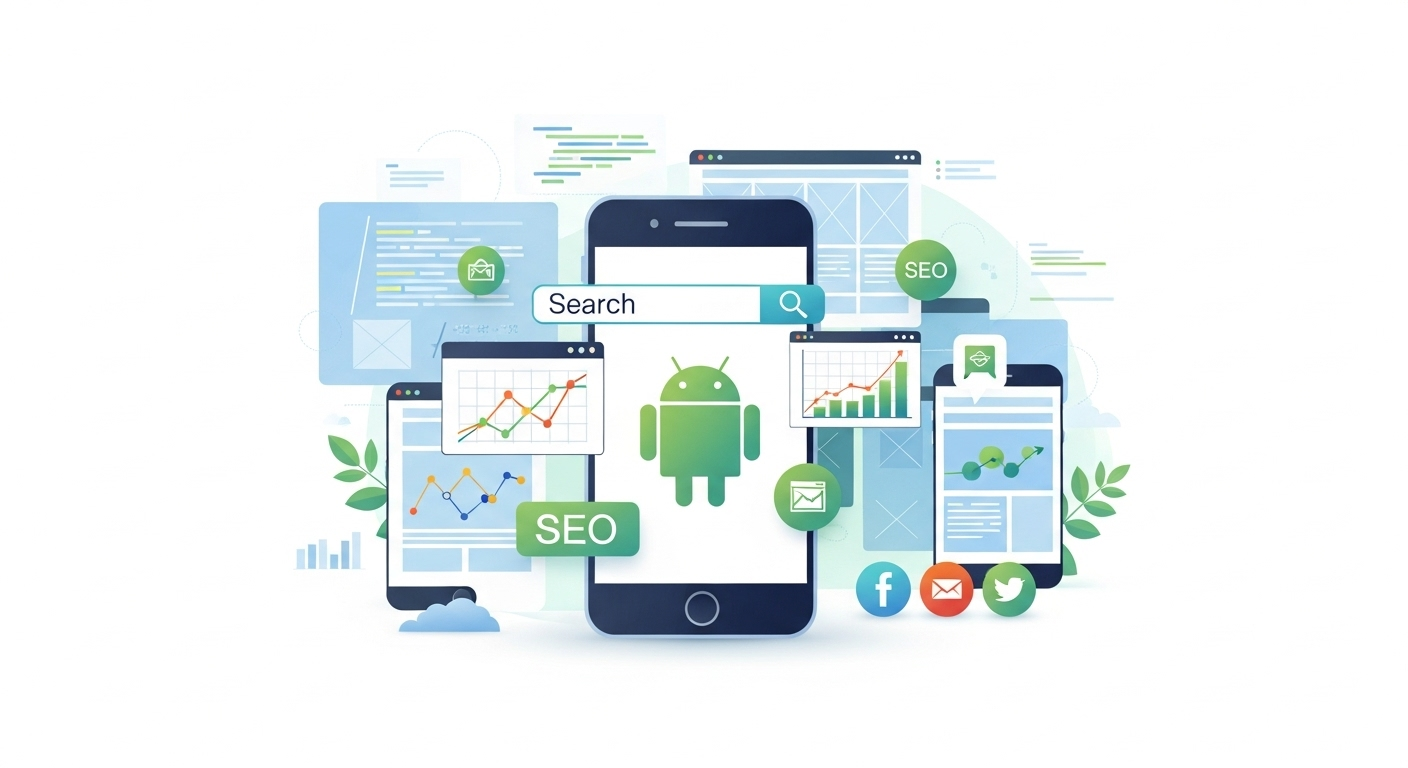Digital marketing for an Android app means using online strategies—like SEO and website development—to promote the app and reach more users. In practice, this involves optimizing both your app’s Google Play listing (App Store Optimization, or ASO) and your app’s website so people can find you easily. For example, you might build a simple website for your app, publish helpful content (blog posts, tutorials, or videos) about its features, and use relevant keywords in both your site content and app description. Together, these steps improve your visibility on Google and in the Google Play Store. In short, by combining an SEO-friendly website with targeted app marketing (ASO), you help more users discover, trust, and download your Android app right away.
Plan Your App Marketing Strategy
Before diving into tactics, start with research and strategy. Think about who will use your app and what problem it solves. Analyze competitors’ apps and websites to see what keywords and channels they use. Then set clear goals (e.g. number of downloads, traffic) and pick the right platforms.
-
Identify your audience: Are they gamers, students, shoppers? What age and interests do they have?
-
Keyword research: Use tools like Google Keyword Planner or SEO suites (Ahrefs, SEMrush, or Surfer SEO) to find terms your audience might search. For example, if your app helps people manage tasks, target keywords like “best to-do list app for Android” or “task manager app.” Including long-tail keywords often attracts engaged users.
-
Set up a website: Create a simple, SEO-friendly site (using WordPress, Webflow, or similar) that serves as a hub. This site can host blog posts, FAQs, and download links. It also helps your app rank in Google searches.
-
Use multiple channels: Plan content for social media, email newsletters, and app review sites. For instance, announce updates on Twitter or Facebook, and encourage reviews. The goal is to make your app visible everywhere your users might look.
This planning phase ensures you use the right keywords and channels, so your content and app reach the right people.
Build an SEO-Friendly Website
Even though you have a mobile app, a website is crucial for SEO. A well-built site can rank on Google, attract organic traffic, and funnel visitors to download your app.
-
Mobile-friendly design: Ensure your site works perfectly on phones. Google now uses mobile-first indexing, meaning it primarily looks at the mobile version of your site when ranking. Use a responsive design so content, headings, and images scale nicely on phones.
-
Speed and security: Fast loading times matter. Compress images and use caching so pages load quickly. Also use HTTPS (SSL) to secure your site. Google recommends HTTPS for safety and even uses it as a (minor) ranking signal. In practice, a secure, fast site helps with user trust and SEO.
-
Relevant content: Populate your site with helpful, original content about the app. Write easy-to-understand pages or blog posts explaining how your app solves problems, with the same keywords you used in app research. For example, a simple blog “How to Use Our Task App to Save Time” can attract readers. Make sure each page has clear titles, headings, and meta descriptions using your target keywords.
-
Images and media: Use screenshots or videos of your app. But optimize them (add alt text, captions, and compress file size) so they don’t slow down the site.
By following these steps, your website becomes SEO-friendly. This means it’s easy for Google to find, index, and show to users who search for related terms. Over time, more organic visitors will discover your app via your site.
Optimize Your App Store Listing (ASO)

Just like SEO helps websites rank on Google, App Store Optimization (ASO) helps your app rank higher in the Play Store. ASO increases visibility and conversions (installs) for free. Here’s what to do:
-
App title and description: Use your main keyword (from earlier research) in the app name and description. For example, if you’re making a “language learning app,” include that phrase. Keep the title concise and descriptive.
-
Keywords: Google Play doesn’t have a separate keyword field (unlike Apple), but it scans your title and description. Naturally weave key terms throughout your description. Also localize your description for other languages if you serve global markets.
-
Visual assets: Create an eye-catching icon and attractive screenshots or demo videos. These visuals appear in the Play Store and heavily influence downloads. A great icon and clear screenshots (with short captions) can boost your conversion rate.
-
Ratings and reviews: Encourage happy users to leave 5-star reviews. Good ratings help your rankings and credibility. You can gently prompt users (e.g. “Enjoying the app? Rate us 5 stars!”) after they reach a milestone. Respond politely to feedback – this shows the app is maintained and trustworthy.
Remember: ASO is like SEO for apps. Both rely on keywords and quality content. But ASO is specific to app stores. If your app isn’t optimized, even the best marketing can fall flat because users can’t find or trust it in the store.
Keywords and Content Strategy
Keywords connect your website and app. Use the same targeted terms in both places so you’re attracting the same audience.
-
Consistent messaging: If you rank for “fitness tracker app,” ensure your blog posts, website, and app description all focus on that theme. This reinforces your expertise.
-
Long-tail focus: Instead of just “fitness app,” target phrases like “free fitness tracker for beginners.” Long-tail keywords often face less competition and attract users who know what they want.
-
Regular content updates: Publish helpful articles, videos, or infographics about your app’s topic. For example, a workout app could share “5 Beginner Workouts You Can Do at Home.” Each new post is another chance to rank for a keyword and bring users to your site (and eventually to your app).
-
Link content between app and site: If possible, include links from your website to open the app (deep links) and vice versa. For instance, a page on your site could say “Download our app on Google Play” and link directly to the Play Store. This unifies your marketing and can boost both SEO and app discovery. (Later we’ll explain deep linking in more detail.)
By integrating keywords naturally into all your content and linking everything together, you create a cohesive marketing funnel. People who find your site via Google can easily download the app, and app users can learn more on your website.
Deep Linking: Connecting Site and App
One powerful strategy is to use deep links so search results can send users directly into your app. In Google’s own terms, deep links connect your website’s URLs with the relevant pages in your app. This doesn’t change how Google indexes your site, but it improves user experience: a searcher clicks your result and, if they have your app, it opens to that exact content inside the app.
Deep linking offers big benefits: for example, users save “an average of 2–3 clicks” because they land exactly where they want in your app. It also helps you track how searchers use your app (better analytics). To implement it, you’ll need to set up App Links in Android (and Universal Links in iOS). Google provides documentation on adding this to your site and app. Once enabled, Google Search Console will even show you how often Android users find your app via search. In summary, deep links make your app and site work together: the site’s pages can drive app engagement seamlessly.
Technical SEO Tips
Behind the scenes, follow these technical best practices so Google can rank you higher:
-
Mobile-first indexing: As noted earlier, Google mainly looks at your mobile site version for ranking. Use a responsive layout (same content on desktop/mobile) and don’t block essential resources. This ensures Google can crawl and index your pages properly.
-
Clean URLs and Sitemaps: Use clear, keyword-friendly URLs (e.g.,
yourapp.com/feature-guide). Submit an XML sitemap to Google Search Console so Google finds all your pages. This is basic SEO but very important. -
Page speed and Core Web Vitals: Make your pages load quickly (under a few seconds). Optimize images, enable browser caching, and minimize code. Google’s tools like PageSpeed Insights can help you identify slow elements. Faster pages lead to better rankings and happier users.
-
Structured data: If applicable, use schema markup (structured data) on your site. For example, marking up a “software application” can give Google clues about your app. While not required, it can improve how your search snippet appears.
-
HTTPS and security: As mentioned, use HTTPS everywhere. Google explicitly encourages moving from HTTP to HTTPS for user safety. A secure website not only builds trust but also avoids browser warnings that scare visitors away.
Adhering to technical SEO best practices makes your site reliable and crawlable, which in turn makes your marketing efforts more effective.
Leverage Tools and Analytics
Use digital tools to streamline marketing and track results:
-
Analytics: Set up Google Analytics (GA4) or Firebase Analytics for your website and app. These free tools can track user behavior, where your traffic comes from, and which keywords people use to find you. (Firebase’s Google Analytics automatically tracks hundreds of events for free.) You can see, for example, if a blog post is driving app downloads or which features users engage with most.
-
App monitoring: Use Firebase Crashlytics or similar to monitor app crashes and performance. Good technical performance (fast load times in-app, low crash rates) positively impacts reviews and user retention.
-
SEO/audit tools: Services like SEMrush, Ahrefs, or SE Ranking can audit your website and suggest keyword improvements. They can also check backlinks and on-page SEO. Many have mobile apps or phone-friendly dashboards so you can monitor on the go.
-
ASO tools: Consider an ASO platform like App Radar, Sensor Tower, or Mobile Action to track your app’s rankings and suggest better keywords. They often offer trial versions.
-
Social scheduling: Tools like Hootsuite or Buffer let you schedule social media posts promoting your app or blog content. Consistent social activity keeps your brand in front of users.
By regularly reviewing analytics, you’ll know what’s working. For instance, if you see most downloads come from organic Google searches, invest more in content SEO. If social posts drive traffic, double down on social channels. Adapt your strategy based on real data to grow sustainably.
Build Authority with Backlinks and Outreach

Just as in web SEO, having other reputable sites link to yours boosts credibility. Quality backlinks tell Google “this site is trusted,” which can improve rankings. Here are some tactics:
-
Guest posts: Write a helpful article related to your app’s field for another blog or tech site, including a link back to your site. For example, a productivity app team might guest post on a productivity blog about work-life balance tips.
-
App directories and lists: Submit your app and site to app directories, technology lists, or relevant forums. A backlink from a known directory can raise your site’s profile.
-
Influencer outreach: If there are bloggers or YouTubers in your niche, consider partnering. They might review your app (linking to your site) or let you contribute content.
-
Shareable content: Create infographics, charts, or useful resources (like an ebook) that others might link to. When you create something valuable, other sites are more likely to reference it.
Remember that quality beats quantity: one backlink from a respected tech site can be worth more than dozens of low-quality links. Overall, earning natural backlinks through genuine value-building will boost your site’s SEO over time.
Conclusion: Engage and Iterate
Digital marketing for an Android app is an ongoing process. In summary: start with your audience and build a strategy around their needs. Optimize your Google Play listing (ASO) and your website (SEO) with the same focus keywords and quality content. Use deep linking so searchers can seamlessly jump into your app content. Leverage analytics tools to track where users come from and how they engage, and adapt based on data.
Finally, treat marketing like a conversation: respond to reviews, engage on social media, and keep content fresh. By combining smart website development, solid SEO, and targeted app marketing, you’ll create a trustworthy presence that helps users discover and love your Android app.





Comments are closed